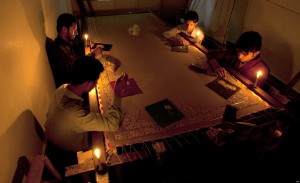 Right in the middle of cooking food or returning home from the winter cold, a sudden power cut interrupts…great! Well actually, not really, especially in the winter months. Last month in December, Dunya News Network reported about the unannounced electricity cuts in Lahore. These cuts lasted for 8 hours. On top of this, daily deliberate electricity cuts last for 10 hours in urban areas and up to 16 hours in rural areas. Governments are negotiating for solutions for Pakistan’s extreme electricity crisis.
Right in the middle of cooking food or returning home from the winter cold, a sudden power cut interrupts…great! Well actually, not really, especially in the winter months. Last month in December, Dunya News Network reported about the unannounced electricity cuts in Lahore. These cuts lasted for 8 hours. On top of this, daily deliberate electricity cuts last for 10 hours in urban areas and up to 16 hours in rural areas. Governments are negotiating for solutions for Pakistan’s extreme electricity crisis.
In October 2014, the News International claimed: “Pakistan is currently facing a natural gas shortfall of over two billion cubic feet per day, which is expected to increase significantly in the next 15 years.”
So, one of the solutions for this crisis was Liquefied Natural Gas (LNG). By the 26th January 2015, Pakistan will have its first LNG receiving terminal. Pakistan’s first receiving terminal will be at Karachi’s Port Qasim. In Pakistan gas is usually used to generate electricity. As LNG is a cheap source of energy it is in high demand. But if a lot of people buy and use LNG, there is a possibility it might run short.
It is believed that the CEO of Engro Elengy Terminal (Pvt) LTD (EETPL), Sheikh Imran-ul-Haq, seems very hopeful that the first LNG product will reach the terminal by March 2015. The first terminal will be able to handle 0.4 billion cubic feet of LNG a day. But when the second LNG receiving terminal is created in the first quarter of this year, Pakistan will aim to import 0.6 billion cubic feet of LNG a day.
Minister of State for Petroleum, Jam Kamal Khan said: “Pakistan has awarded a contract to build a second LNG terminal to government-controlled Sui Southern Gas Company and is considering building two more in the next 2½ years.”
 Natural Gas Asia very recently reported that China will finance the LNG project in Pakistan. The financing will go towards constructing the pipeline from Gwadar to Nawabshah which will be the second terminal to be completed in February 2015.
Natural Gas Asia very recently reported that China will finance the LNG project in Pakistan. The financing will go towards constructing the pipeline from Gwadar to Nawabshah which will be the second terminal to be completed in February 2015.
A second solution is the Dasu Power Project. Businessmen from the United States have shown interest in supporting Pakistan’s electricity crisis. It is claimed that funding for the Diamer-Bhasha Dam has been received and this project has already been started.
Here’s a third solution for Pakistan’s electricity crisis; solar power. In August 2014, the BBC talked about the Pakistan government being interested in solar power. Companies and households can use solar power to regenerate electricity for Pakistan’s long hours of electricity cuts.
Pakistan’s electricity crisis means that this country usually struggles in sudden blackouts for up to 20 hours a day. But with a few solutions at hand, will these help bring back Pakistan’s deserved electricity?





















